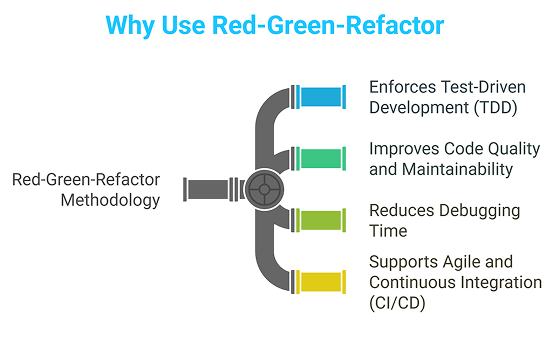Maintaining code quality while ensuring rapid feature delivery is a challenge in modern software development. One of the most effective techniques to achieve this balance is Red Green Refactor (RGR).
What is Red Green Refactor?
The Red Green Refactor technique is a three-step iterative process used in test-driven development (TDD) to incrementally write and improve code. It consists of:
- Red : Write a failing test.
- Green : Write the minimum code required to pass the test.
- Refactor : Improve the code while ensuring all tests still pass.
RGR ensures that tests always cover new functionality and continuously refine the codebase.
1. Red: Write a failing test
- Start by defining the expected behavior of the function or feature.
- Write a test case that captures this behavior.
- Run the test suite. The new test should fail (red state).
- This step forces developers to define requirements clearly before implementation.
Example (in Python using pytest):
import pytest
from calculator import add
def test_addition():
assert add(2, 3) == 5Since the add function doesn’t yet exist, running this test will result in an error.
2. Green: Write just enough code to pass the test
- Implement the simplest possible solution to make the test pass.
- Avoid adding extra functionality. Focus solely on satisfying the test.
- Run the test again. Now, it should pass (green state).
Example (minimal implementation to pass the test):
def add(a, b):
return a + b3. Refactor: Improve code quality without changing behavior
- Optimize the implementation while ensuring all tests still pass.
- Remove duplication, improve readability, and apply best practices.
- Continuously verify functionality by running the test suite after each change.
Example (refactored for better structure):
def add(a: int, b: int) -> int:
"""Returns the sum of two numbers."""
return a + bThis process is repeated for every new feature or modification, ensuring systematic development.
Why Use Red Green Refactor?

1. Enforces test-driven development (TDD)
- Ensures every feature is backed by tests from the beginning.
- Reduces the likelihood of introducing bugs later in development.
2. Improves code quality and maintainability
- Encourages small, manageable changes.
- Helps developers write clean, modular, and reusable code.
3. Reduces debugging time
- Bugs are caught early because tests drive the design.
- Developers spend less time diagnosing unexpected behavior.
4. Supports Agile and continuous integration (CI/CD)
- Enables faster, more reliable deployments.
- Ensures that refactoring does not introduce regressions.
Common Challenges and Solutions
- Writing too many tests too early
Solution: Start with the simplest test case and develop it incrementally. - Over-refactoring
Solution: Follow the [YAGNI principle](https://www.techtarget.com/whatis/definition/You-arent-gonna-need-it#:~:text=YAGNI%20principle%20(%22You%20Aren’,desired%20increased%20frequency%20of%20releases.) (You Aren’t Gonna Need It). Only refactor what’s necessary. - Ignoring the refactoring step
Solution: Make refactoring a mandatory step before moving on to new features. - Handling legacy code
Solution: Use the strangler pattern. Gradually introduce tests and refactor the codebase over time.
Red Green Refactor in Real-World Development
While the Red Green Refactor technique is widely used in test-driven development, its real-world application varies across projects. Here are some practical use cases where this method proves invaluable:
1. Developing scalable web applications
- Ensures APIs and services handle requests correctly before deployment.
- Helps maintain backward compatibility when updating critical features.
- Enables continuous refactoring without breaking existing functionality.
2. Microservices and cloud-native architectures
- Each microservice can have independent tests, ensuring functionality is isolated and reliable.
- Helps prevent cascading failures in distributed systems by validating changes at the service level.
3. DevOps and continuous integration/continuous deployment (CI/CD)
- Automated testing frameworks integrate seamlessly with CI/CD pipelines.
- Detects failures early in development, reducing deployment risks.
- Enables faster feedback loops for developers, leading to higher productivity.
4. Legacy system modernization
- Introduces test coverage before refactoring old codebases.
- Ensures stable incremental improvements without breaking existing functionality.
- Allows gradual migration to new frameworks or architectures.
Conclusion
The Red Green Refactor cycle is a simple yet powerful approach to writing better code. It helps developers ensure that every feature is tested, code remains clean, and improvements don’t introduce new bugs. Although Red Green Refactor workflows take a bit more effort than traditional development, their long-term benefits, like fewer errors, easier maintenance, and faster development, make them well worth the effort.
